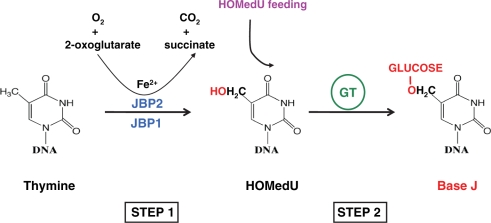Figure 7.
Proposed mechanism of JBP1 and JBP2 catalyzed thymidine hydroxylation. The two-step J-biosynthesis pathway in T. brucei. Indicated is the proposed mechanism of JBP2/JBP1 catalyzed hydroxylation of thymidine residues during the initial step of the pathway, as discussed in the text. Bypassing Step 1 (and therefore JBP catalyzed thymidine hydroxylation) can be achieved through feeding cells HOMedU, as indicated. The absence of base J in the genome of the J null cell, but its ability to convert incorporated HOMedU to J, indicates that only Step 1 of the synthesis pathway is ablated upon deletion of JBP1 and JBP2. The glucosyl transferase (GT) enzyme is still active in this cell line.

